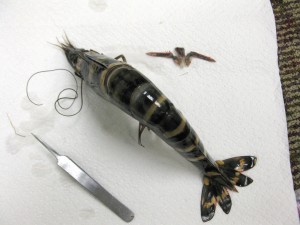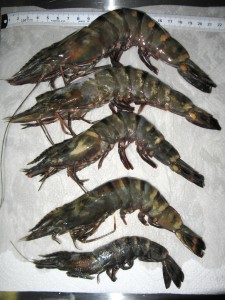
This catchy phrase coined by Robert Turpin (Escambia County Marine Resources Division) describes the new invader to our marine waters. Many coastal residents are aware of the invasive lionfish that has invaded our local reefs but few have probably heard of the Asian Tiger Shrimp. This member of the penaid shrimp family, the same family are edible white, brown, and pink shrimp come from, was brought to the United States in the 1960’s and 70’s as an aquaculture project. Over the years farmers have moved from Tiger Shrimp to the Pacific White Shrimp and the last known active farm was in 2004.
In 1988 2000 of these shrimp were lost from a farm in South Carolina during a flood event. 10% of those were recaptured and some were collected as far away as Cape Canaveral. No more was heard from this release until 2006 when 6 were captured; one of those in Mississippi Sound near Dauphin Island. Each year since the number of reported captures has increased suggesting they are breeding.
2006 – 6 captured
2007 – 4 captured
2008 – 21 captured
2009 – 47 captured
2010 – 32 captured
2011 – 591 captured
One individual was caught in 2011 near Panama City and 5 were collected in 2012 in Pensacola Bay. In recent weeks the Sea Grant Agent in Escambia County has received reports of numerous Tiger Shrimp being collected from Escambia Bay. There is currently no scientific evidence of negative impacts of this shrimp in our area. They are aggressive predators of benthic invertebrates and may out compete our native penaid shrimps and could possibly feed directly on the juveniles.
NOAA scientists are interested in obtaining samples of this shrimp for DNA studies. It differs from other local penaid shrimp in that it is larger (8-12” long), dark in color (dark green to black) and has light stripes (white to cream colored). The larva and juveniles live in the bay. Sub adults will migrate offshore for breeding. They are a tropical species that have a low tolerance for cold temperatures, showing no growth below 20°C, but have a high tolerance for changes in salinity. If you thing you may have one of these shrimp and are interested in donating one, please contact Sea Grant Agent Rick O’Connor at (850) 475-5230 or roc1@ufl.edu.
Posted: November 8, 2014
Category: Natural Resources, Wildlife
Tags: Gulf, Lions, Panhandle Outdoors, Tigers



